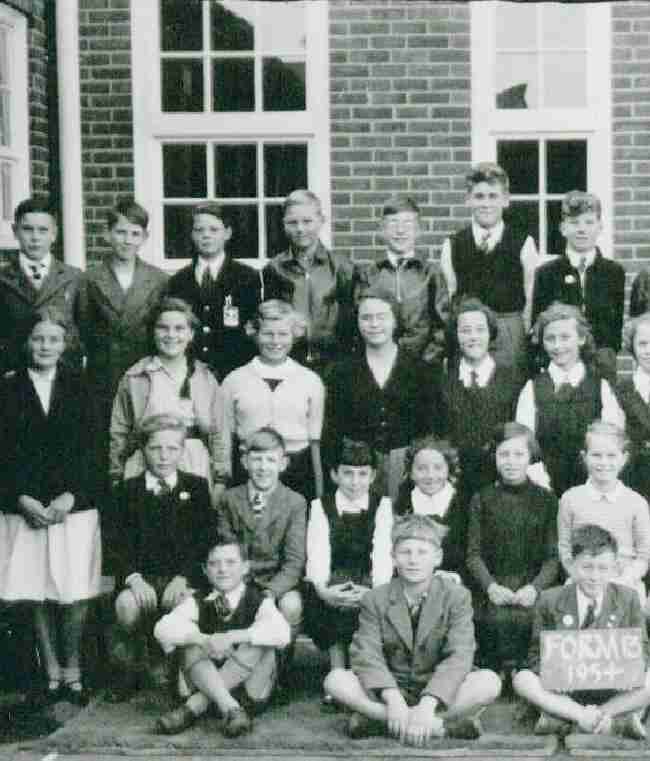
English School Uniform: Variations in Form Level Terms

Figure 1.--The sign tells us this portrait was taken in 1954. Its looks us like Form 1 at a secondary school with 11-12 year olds. The sign labels this Form 13. This was not a common way of labeling this grade level. Click on the imahe to see the rest of the class. Notice only one boy wears school sandals. The coding suggests this is Ward Schoolmin Yorkshire, but we are not sure.
|
The terms for the various grade levels (forms) was fairly consistent throughout England. These commonly used terms are detailed here (figure 1). There was, however, no uniformly accepted term as was the case in the United states with its grades 1-12. We note several different ways of labeling grade levels. Some private schools had their own grade level systems. While this was most common at individual schools, especially private schools, we notice some communities had state schools with detinctive grade system. While not common, these destinctive grade lavel systems did exist. Note here there appears to be a Form 13. We have not seen that before. A British reader tells us, "The answer to your question . It is not form 13 but form 'B'. It is the photographer's fancy writing that is mis-leading you." We thought of that, but wonder why there is not a number such as Form 1B or 2B. I supose the school might have had just two boards prepared to identify the A and B forms in each year leaving it up to the photographer to figure out the year. Some schools numbered forms beyound the standard 1-6 form method. Apparently some schools had systems that were no based on a form level equating to 1 caldendar year. A reader writes, "When I was at primary school we went up to class 17. You had classes 1-4 which were 1st years (7-8) going up to classes 14-17 which were 4th years (10-11). Bear in mind that we also had a seperate system over here of First (5-8) and Middle Schools (8-13) and this may explain why Form 13 are
aged about 11-12." Another reader writes, "Primary and secondary school, were streamed in the 1950s. You had the A stream and B stream and the special needs C stream. This worked better at scondary level. There would be A and B streams. depending on the size of the school there might be a need to split a stream into two sections 1A 2A or 1B 2B. In the photograph I think what looks like 13 is in fact likely to be Form B. The number of children suggest that there is only 1 form thus form B would be all that would be needed. 13 seems a strange number to have because there would not be that number of classes.
If it is 13 then we are looking at a strange situation indeed. The numbers do not add up when you consider a school with that had an infant, primary and secondary school all on the same site. HBC has worked on just what the standard form designations mean. All this leads to me to think its the letter B and not 13 denoting a class in a secondary school. The possibility of it being something quite different is still a consideration." We note that in Britian today there is a Year 13 designation (the old Upper VI Form). But this is for students 17-18 years old, nit thevyounger secondary students here.
HBC-SU

Related Chronolgy Pages in the Boys' Historical Web Site
[The 1880s]
[The 1930s]
[The 1940s]
[The 1950s]
[The 1960s]
[The 1970s]
[The 1980s]
Related Style Pages in the Boys' Historical Web Site
[Long pants suits]
[Short pants suits]
[Socks]
[Eton suits]
[Jacket and trousers]
[Blazer]
[School sandals]
Navigate the Boys' Historical Clothing School Uniform Pages
[Main School Uniform Type Page]
[Australia]
[England]
[France]
[Germany]
[Italy]
[Japan]
[New Zealand]
[Scotland]
[United States]
Navigate the Boys' Historical Clothing Web Page
[Return to the Main English age and form level page]
[Introduction]
[Activities]
[Biographies]
[Chronology]
[Clothing styles]
[Countries]
[Bibliographies]
[Contributions]
[Essays]
[FAQs]
[Glossaries]
[Satellites]
[Tools]
[Boys' Clothing Home]
Created: May 4, 2004
Last updated: May 6, 2004




